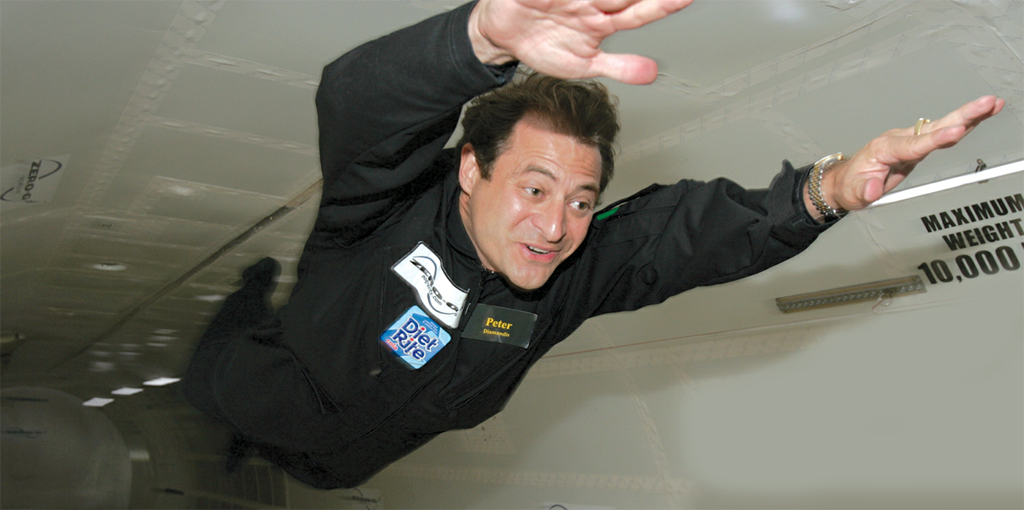
>>>When given a choice, take both.
>>>Do it by the book, but be the author!
>>>When forced to compromise, ask for more.
These are just 3 examples from my list of 28 Peter’s Laws that I’ve accumulated over the past 20 years.
They are basically principles and truisms that have guided me in times of difficulty and opportunity, my go-to principles when the proverbial shit hits the fan.
I write about them in depth about them in my new book BOLD – How to Go Big, Create Wealth, and Impact the World, which you can order here.
Here’s a few of my most precious insights…
Enjoy.
P.S. Send any tips to our team by clicking here, and send your friends and family to this link to subscribe to Abundance Insider.
The Origin of Peter’s Laws… to hell with Murphy
During the earliest days of my second company, International Space University (ISU), I shared an office with Todd Hawley, who as a joke put a copy of Murphy’s Law on the wall. That depressing advice—"If anything can go wrong, it will"—stared at me every day. It also started to get under my skin. A week into Murphy’s mental assault, I went to the whiteboard behind my desk and wrote: “If anything can go wrong, fix it! (To hell with Murphy!)” Then above the quote I wrote, “Peter’s Law.”
>>>The best way to predict the future is to create it yourself!
I’ve seen variations on this quote attributed to everyone from Abraham Lincoln to Peter Drucker—which certainly makes it enduring. And for good reason. The future is not preordained. It unfolds as a result of action—the choices you make and the risks you take. At a very fundamental level, this is exactly what it means to be an entrepreneur. Have a vision for tomorrow, pull yourself toward it. I wanted a future that included private commercial space flight, so I launched the XPRIZE. I saw asteroid prospecting as a viable reality, so I co-founded Planetary Resources.
>>>When faced without a challenge—make one!
We humans are hardwired for challenge. This is why flow—the state of optimal human performance—shows up only outside of our comfort zone, when we are pushing limits and using skills to the utmost. Want proof? How about the significant correlation between early retirement and death? According to a 2005 report in the British Medical Journal, people who retire at 55 are 89 percent more likely to die in the ten years after retirement than those who retire at 65. We need to be alive to stay alive, simple as that.
>>>No simply means begin one level higher!
When someone says no, it’s often because they’re not empowered to say yes. In many organizations, the only person who can say yes is the one atop the food chain. When I was in graduate school, I was desperate for a ride on NASA’s zero-gravity (parabolic flight) airplane. I tried everything to get aboard (including volunteering as a medical guinea pig), but could never get permission. So I took things to the next level, partnering with two friends to start a commercial company (Zero-G) to offer this same service.
But getting permission to start this service took a while—11 years, to be exact. Over the next decade we battled an army of FAA lawyers who all insisted that large-scale commercial zero-g operations were not possible under the federal aviation regulations, despite the fact that NASA had been operating parabolic flights for over 30 years. They kept demanding that I show them where in the regulations it says an airplane is allowed to fly parabolic arcs. I had only one answer: “Show me where it says I can’t.” Quite simply, none of these mid level bureaucrats had the power to say yes. Finally, a decade later, my request made it all the way up to the FAA administrator, Marion Blakey, an amazing woman who had the right answer: “Of course you should be able to do this—let’s figure out how.”
>>>If anything can go wrong, fix it! (To hell with Murphy)
Back in 2007, I decided that world’s foremost expert on gravity deserved the opportunity to experience zero gravity, so I offered Professor Stephen Hawking a parabolic flight. He accepted, and we issued a press release. This is when our friends at the FAA—whose unofficial motto is clearly “we’re not happy until you’re not happy"—reminded us that our operating license permitted us to fly only "able-bodied” passengers, and Hawking, being totally paralyzed and wheelchair bound, did not qualify.
But to hell with Murphy. I decided to fix the problem. First, we had to determine who—in the FAA’s mind—decides that someone is able-bodied? Second, if we could get that someone to declare Hawking “able-bodied,” we still had to de-risk our moonshot and ensure his safety.
After wading through lawyers, we determined that only Hawking’s personal physicians and perhaps experts from the space-medicine world were qualified to make that call. So after purchasing malpractice insurance policies for a few of these folks, we were able to submit three letters to the FAA stating, without question, that Hawking was fit for a flight.
To address the second challenge, we decided that four physicians and two nurses would accompany him on the trip, then assembled a flying emergency room on board the airplane and flew a lengthy practice flight, training the medical team for everything from a heart attack to broken bones. We also decided (and announced to the public) that we’d fly a single 30-second parabola, and maybe, if everything went perfectly, a second one.
At least that was the plan. The problem with the plan was Hawking. Not only did he endure that first parabola, he had—as he told me—the best time of his life. So we flew another and another and still he wanted more. In total, we made eight arcs with him aboard. Then, on the heels of this success, we had the amazing opportunity to fly six wheelchair-bound teenagers into zero gravity. These were kids who had never walked a day in their lives, yet they got to soar like superman on that flight. The moral of the story: Stuff goes wrong. Expect it, learn from it, fix it—that’s how remarkable happens.
>>>When given a choice—take both!
We’re taught that when you are given a choice you have to choose only one option. But why choose? All through graduate school I was told to either go to school or start a company. It was binary or bust. But not for me. In my case, the answer was both and then some. I started three companies while in graduate school. I started eight more before I was 40. Steve Jobs juggled both Apple and Pixar. Elon Musk runs three multibillion-dollar successes: Tesla Motors, SpaceX, and SolarCity. Branson, well, alongside his Virgin Management group, has started over 500 companies, including eight billion-dollar companies in eight different industries. This multiple-choice approach—if properly managed—can create tremendous momentum. Ideas cross-pollinate. Networks expand. The whole becomes much bigger than the sum of its parts.
>>>An expert is someone who can tell you exactly how something can’t be done.
When I first dreamed up the XPRIZE, I went to all the major aerospace contractors looking for funding. They were dismissive. When the prize was announced, these same experts derided it. It took only eight years for Burt Rutan to prove them wrong. Henry Ford, when asked about his employees, said it best:
“None of our men are ‘experts.’ We have most unfortunately found it necessary to get rid of a man as soon as he thinks himself an expert because no one ever considers himself expert if he really knows his job. A man who knows a job sees so much more to be done than he has done, that he is always pressing forward and never gives up an instant of thought to how good and how efficient he is. Thinking always ahead, thinking always of trying to do more, brings a state of mind in which nothing is impossible. The moment one gets into the 'expert’ state of mind a great number of things become impossible.”
… and this is only a fraction of the stories behind Peter’s Laws.
If you want more, be sure to order a copy of BOLD.
My team and I threw in a few amazing Free Bonuses for you if you pre-order during this next 10 day period.
WHAT IS ABUNDANCE INSIDER?
This email is a briefing of the week's most compelling, abundance-enabling tech developments, curated by Marissa Brassfield in preparation for Abundance 360. Read more about A360 below.
WANT MORE CONVERSATIONS LIKE THIS?
At Abundance 360, Peter's 360-person executive mastermind, we teach the metatrends, implications and unfair advantages for entrepreneurs enabled by breakthroughs like those featured above. We're looking for CEOs and entrepreneurs who want to change the world. The program is highly selective. Apply now for Abundance360 Summit if you'd like to develop an Abundance Mindset.
Know someone who would benefit from getting Abundance Insider? Send them to this link to sign up.







